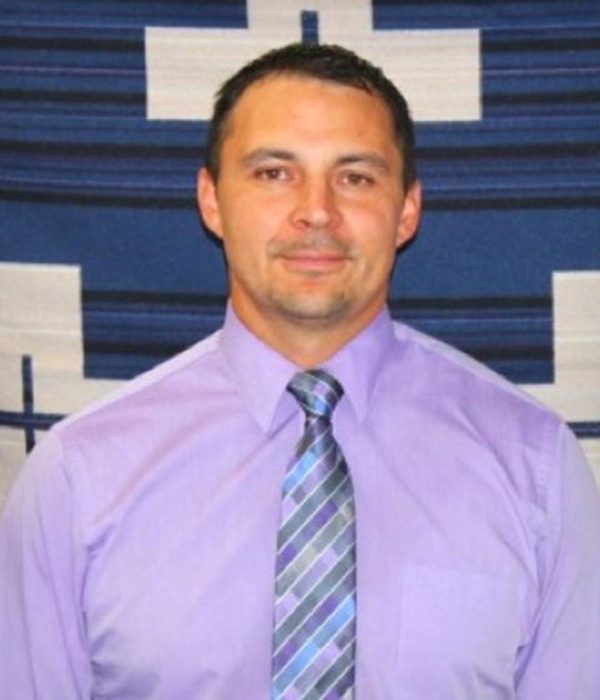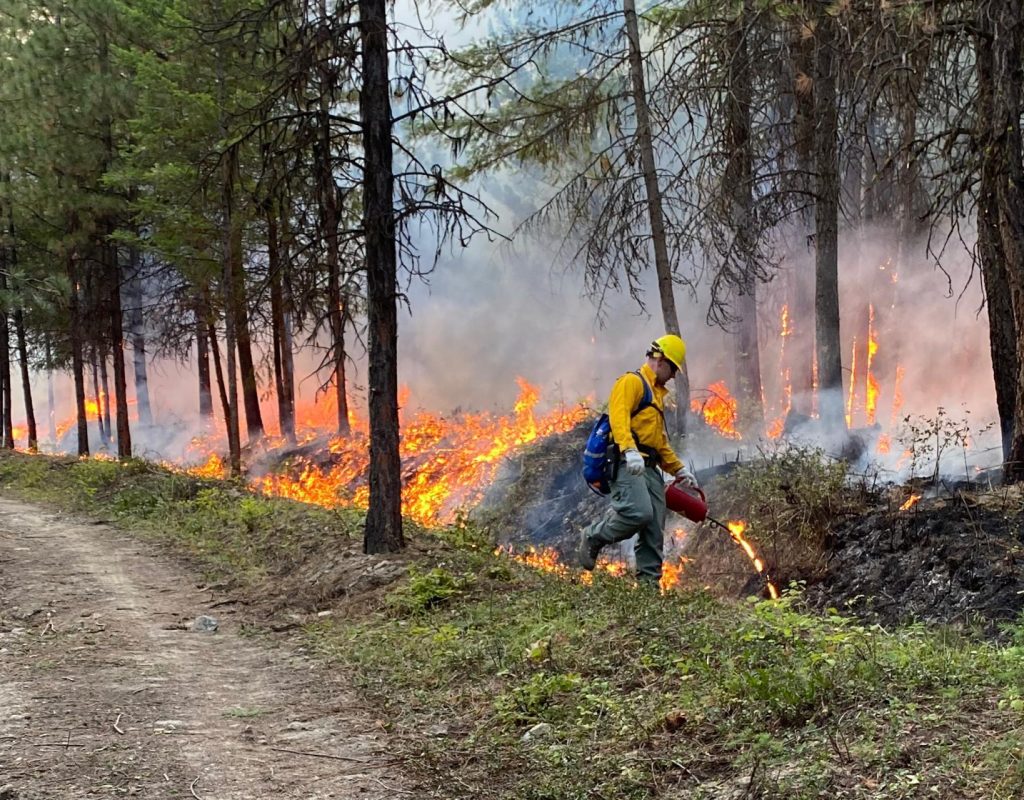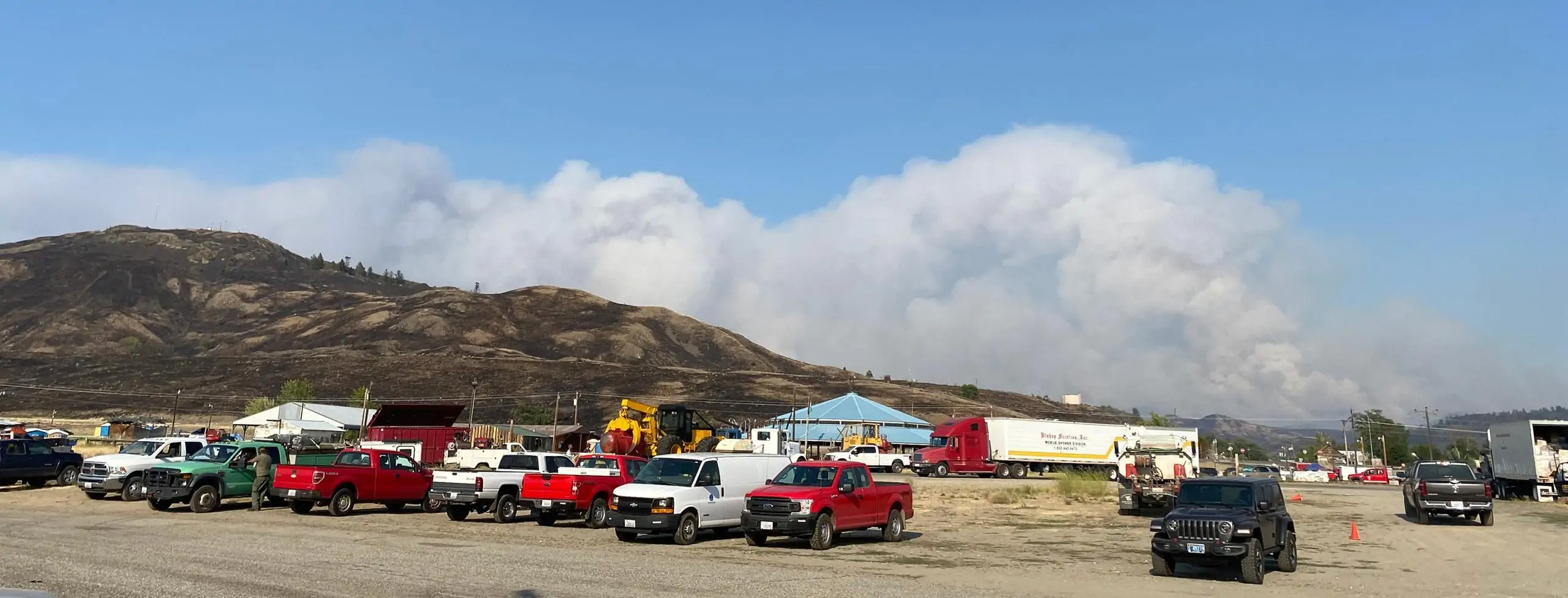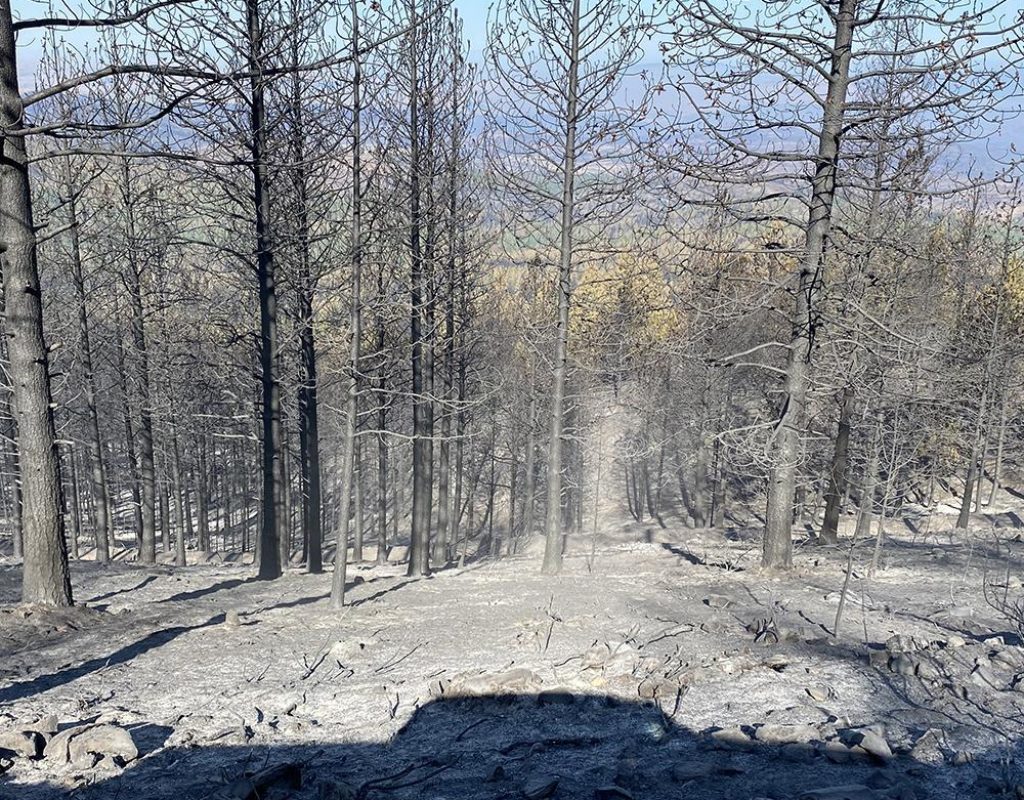
Director of the Indigenous Leadership Program
Photo taken from the front door of the Confederated Tribes of the Colville Indian Reservation Tribal Government Center on the first night of the Chuweah Creek Fire, July 12, 2021. It started at 7 pm. Photo credit: Cody Desautel
On an afternoon in late January, Cody Desautel, the director of the natural resources department for the Confederated Tribes of the Colville Reservation, sat down with Brent Davies and other Ecotrust staff to discuss the impacts of climate change on the Tribes’ forest and economy and how they are responding to threats on the landscape. It’s a wide-ranging conversation that shows the considerations and concerns of a forest tribe during these uncertain times.
This interview was conducted through a partnership with the Bonneville Environmental Foundation with funding provided by the Climate Resilience Fund for the Treeline Project. It was first published in the April issue of the Treeline newsletter.
Good afternoon, Cody. Can you tell us where the Confederated Tribes of the Colville Reservation’s traditional territory is and the extent of your boundaries?
The reservation was created by executive order in 1872 and originally encompassed about 2.9 million acres. It was everything west and north of the Columbia River, to the Canadian border, and then east of the Okanagan River. Then in 1891, there was an agreement with the federal government—I don’t know how agreeable it was to the tribe at the time—where 1.5 million acres was ceded back to the federal government—an area we call the former north half. The current-day reservation is 1.4 million acres, located in north central Washington state. It is the home of the 12 tribes that are part of the Colville Confederacy, which were included in the constitution which passed in 1937.

How have your people traditionally cared for land from pre-settler contact to now?
The management tool we utilized most was fire. It was the tool used across much of the west, and that’s something that’s rarely considered when we look at desired future conditions, historic fire regimes, and fire return intervals. Our people were mindful of how, when, and where they gathered traditional foods and medicines. It wasn’t what you would consider agriculture as we know it in a modern context, but definitely there were cultivations of plants that were important to the tribes. There were certain ways that we learned and practiced gathering to ensure that species, such as camas and bitterroot, were perpetuated and that they would always be available for subsistence. It was a very different lifestyle where you had to have those things to survive through the year. Those foods were not something we consumed out of convenience; they were necessities. If you ever tasted bitterroot, you know what I’m talking about. You don’t eat bitterroot because it tastes good.
You’ve been working for the Tribes for the past 25 years. What changes have you noticed to the land and what might you attribute to a changing climate?
A very drastic change I’ve seen over my career is the scale, intensity, and frequency of disturbance, primarily fire. Insect and disease activity has picked up, but that’s fairly minuscule compared to the number of acres that have burned. When I first started reading the Intergovernmental Panel on Climate Change (IPCC) reports and hearing discussions about climate change, [my colleagues and I] recognized we were having more frequent and bigger fires than we had historically and that we were having a much harder time suppressing them. We were seeing extreme weather events like we hadn’t seen in the past, primarily wind events. Frankly, on those days, we were just getting our butts handed to us on wildfires. So, we started evaluating, “if [increased frequency and severity of fire] was the trend, was that trend going to continue? Was it going to get worse?”

Fire crews working the Summit Trail Fire, which was started by lightning at 10:30 pm on Monday, July 12, 2021, on the Colville Reservation, nearly four hours after the Chuweah Creek Fire started on the same day. Photo Credit: Cody Desautel
We started looking at climate change predictions. At the time, they predicted that in 25 to 40 years, we would see a 250 percent to 400 percent increase in burn acres. But we saw more than that. In the last six years, almost 700,000 acres of a 1.4 million acre reservation burned. That’s by far the biggest indicator that climate change is real. We also have longer, hotter fire seasons with drier conditions. It seems we set a record every year for the energy release component (ERC), the metric we use to track the potential for large fire growth. When we look at restrictions we put on the forest for Industrial Fire Precaution Levels (IFPL) and other factors that evaluate fire risk and danger, they just seem to get a little worse every single year.
How have these changes and these fires impacted the Tribes’ cultural resources?
If half the reservation burns, that’s a significant portion of our cultural resources lost. In 2015, about 800 million board feet of timber burned. We’re redoing our forest inventory now, but I’m sure it’s well over a billion feet in total, particularly after the 2021 fire season where a big fire went through one of our most productive timber grounds. So, we’ve probably burned up more timber in the last six years than most reservations in the rest of the country have. From an economic standpoint, we don’t know what the long-term implications are yet. Thankfully, we haven’t had to reduce our forest restoration accomplishments due to wildfire. We recognize the forest is going to burn, and it’s likely going to burn soon. So, any work that you can do ahead of it is probably going to buy you something, at least from the fire severity standpoint.
How has climate change and a more drastic fire season impacted tribal businesses associated with natural resources?
Timber has always been a significant portion of the Tribes’ revenue. It supports the governmental functions and basic services we provide to our tribal members, like health care, education, and law enforcement. If you take away that revenue stream, with the limited funding we get from the federal government already, it would really hurt. I don’t know that we’ve necessarily seen a negative impact yet, but I’m sure it’s coming because of the number of acres that have burned. Many of those stands were 100-plus years old. Based on our management approach, it will take us about 80 years to get them back to a size class and a forest structure where we can harvest them again.

Big smoke, view from the incident command post of the Chuweah Creek Fire. The fire was started by lightning on July 12, 2021, at around 7 pm, east of Nespelem, Washington. It burned more than 36,500 acres. Photo credit: Kathy Moses, Public Information Officer, Colville Tribes
You’ve had sustained trauma in your community because of all the fires. What does the community go through when there is a big fire?
That’s tough to quantify, but it has definitely changed people’s perspective and priorities. We just finished a research project with the University of Washington trying to understand smoke inhalation, the human health impacts of poor air quality, and how people perceive smoke. What they recognize is that people perceive fire, but they don’t really pay attention to smoke regardless of how bad the air quality is, because there’s a higher risk over the hill, which is fire. They can see the fire coming. I’ve had to answer calls from people who are just scared to death because they see smoke. Historically, tribes would have seen smoke and said, ‘Alright, somebody’s doing something up the hill that they’re supposed to be doing.’ Now that mindset has completely reversed.
Any time there’s smoke nearby, there’s panic. I’m sure it’s similar to post-traumatic stress disorder associated with people’s experience with fires over the past decade or so. Historically, that wasn’t the case. If we talk to our tribal elders, they tell us, “You guys need to be burning more; you’re setting us up for the big one, if you don’t learn it now.” And they’re right. I’ve been hearing it my entire forestry career. I think we knew they were right. We just didn’t have the flexibility or funding to do what we thought we should do.
So I don’t know how we quantify the trauma. I think for people my age and younger, this has become the norm or we’re almost numb to it. You just expect that there’s going to be a massive fire every year or at least every other year. And it’s like, “Oh, boy, here we go.”
“
You always hear about Seven Generations in Indian Country. It’s a difference in perspective. We don’t inherit the earth from our ancestors. We’re borrowing it from our future generations. Those are two very different mindsets and decision points.”
As the impacts of climate change continue to worsen, how are tribes planning for it?
I think tribes are going to be the most impacted [by climate change]. Indigenous communities are going to struggle, whether here or around the world. We are probably the least represented and have the least flexibility to move at the rate we’re seeing. Historically, tribes would have moved when conditions changed, but that would have been slow change, with lots of time to move your people and infrastructure. So if you’re the Colville Tribe and half a million acres are burning up every six years, you’re stuck with whatever is left after the smoke clears. Which is unfortunate, because, historically, we would have gone somewhere else that wasn’t burned. But that’s not an option now. And that’s true of tribes across the country. If you’re a western Washington tribe that has 3,000 acres—not a million and a half like we do—the likelihood of being impacted is huge.
For right now, I think we’re doing pretty well on the resource side. We’ve done a lot of good work over the last 40 years since we transitioned forest management practices. What we see for post-fire effects is considerably better than most adjacent federal and/or state lands that have burned. We have a mixed severity burn on the landscape that’s similar to historic patterns. Definitely a little worse because of the conditions it’s burning under today, but we have islands of green—lots of them.
From a social perspective, I don’t know how we solve that problem. We have tried to look at other ways to generate revenue. We’ve looked at gaming, our tax compacts, and other ways that the tribal government can generate revenue and diversify, so that we can have a consistent economic base to ensure we have plenty of jobs here, that we have comparable wages, that we can build housing and infrastructure to support the tribal membership and give them opportunity. But as you know, that’s difficult everywhere in the country right now. But we do recognize the problem and are trying to build that economic base to provide [stability and opportunity] going forward.

Are tribes prepared for climate change?
I think so. If you look at who’s done a good job for a long time, tribes have always managed in a sustainable way. And it was never for climate change. Tribes recognize the value of clean air, clean water, good wildlife habitat, access to all of those things that culturally identify them. We have the perspective that you have to live with the environment. If you read those early journals from the explorers, they would ask the tribal people they encountered, “Well, who owns this?” and tribal people would respond, “Nobody owns it.” Tribes see themselves as a part of the natural environment, with a role to play like all other living things.
You always hear about Seven Generations in Indian Country. It’s a difference in perspective. We don’t inherit the earth from our ancestors. We’re borrowing it from our future generations. Those are two very different mindsets and decision points. The western world looks at things primarily from a resource extraction perspective. “How can what’s on the landscape benefit me?” versus “What can I do to make this world a better place?”
Are you hopeful humans will make the shifts needed to lessen the impacts of climate change?
I think we will. It’ll be begrudgingly, and it’ll be slow. I think you see enough traction, both politically and socially, especially over the last 10 years. Sadly, disaster is the mother of change. So whether it’s really bad hurricanes in the southeast, or rising ocean levels that submerge cities, or massive fires, there are a number of different things that are pushing people to think about what we’re doing and what the impacts are going to be. And, what the costs are. Even if you look at it purely from an economic standpoint, what is it going to cost to deal with all these things in the future? It’ll probably be the financials that will make us change eventually.
If you look at what California spent on fire suppression in 2018, it was about a billion dollars based on reports I’ve read. But the insurance industry spent $10 billion on replacing all the infrastructure that burned, based on those same reports. And that was a bad year, but it wasn’t the worst year they’ve had. The total costs are huge, particularly when you start looking at restoration of those fires and the timeline to fully recover those landscapes.
I argue on a regular basis that we put so much focus on defending homes, particularly expensive vacation homes, which can be rebuilt in about a year. If you burn down an old growth forest, you’re 250 years from having that back, presuming you do everything right over the first 100 or so years. So I think we need to change our priorities a bit after we’ve ensured people are safe. We’re almost to that point. Hopefully, we recognize it before it’s too late. Otherwise, the road back is going to be long.

bLOG
An interview with Gabe Sheoships, the Executive Director of Friends of Tryon Creek

BLOG
An interview with Mike Durglo, Jr., the Tribal Historic Preservation Office director for the Confederated Salish and Kootenai Tribes.